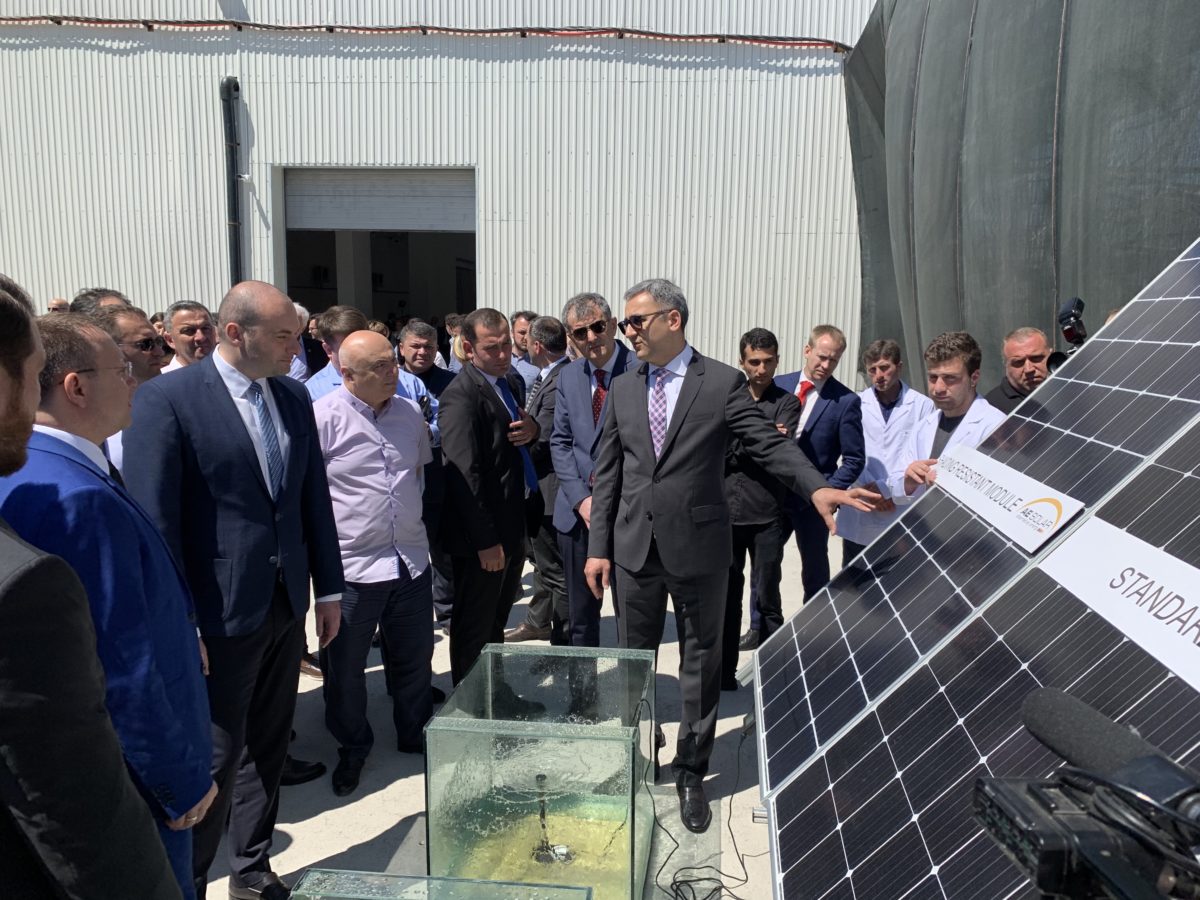At this morning’s ceremony Georgia’s Prime Minister Mamuka Bakhtadze listened attentively as AE Solar’s Chief Business Development Officer Shokhrukh Baratov explained the German manufacturer’s patented smart hotspot free technology by comparing the power output of one standard module to a module outfitted with this technology. While these smart modules cost about twenty percent more than standard modules they provide almost 30 percent more output on average. And that over the lifetime of the module. The technology involves the placement of micro-diodes at each cell in the solar panel. Unlike regular modules, where debris, dust or shading of one or more cells can severely reduce the power output of the entire module, AE Solar’s smart modules limit the impact to the affected cell(s), thereby isolating the impact to just the affected area.
This demonstration formed part of today’s opening ceremony of a 500 MW module assembly factory in the outskirts of Kutaisi in western Georgia. According to Baratov, the factory can be readily expanded to about 1.2 GW and the first 500 MW phase should be fully operational in the course of next month. Combined with AE Solar’s existing 525 MW module assembly plant in China, the German manufacturer can now mobilize a total of over 1 GW in production capacity.
Locating a PV module production facility in Georgia is not for the faint of heart. This is a pioneering venture in a country at the edge of Europe in the Caucasus mountains near Turkey and Russia. Up to 500 people will work at this new factory and so far there is very little solar PV industry in this country of 3.7 million. So why this move? Georgia is strategically located close to important European, Asian and Middle Eastern markets. In fact, one of the investors of this new facility hails from Saudi Arabia, a key future market for AE Solar.
Not only are these markets geographically close to Georgia, but a range of countries (including Saudi Arabia) have trade and other agreements in place with Georgia to facilitate trade and business in general. AE Solar learned the significance of this when the European Union imposed a Minimum Import Price (MIP) on Chinese panels, severely impacting the company’s ability to ship modules from its Chinese factory to Europe.
While the European MIP is a thing of the past, this experience has led the management of AE Solar to diversify its manufacturing footprint. At the same time the company is expanding its technology portfolio with the new facility in Kutaisi scheduled to produce both PERC and bifacial modules by the end of this year. Even n-type heterojunction modules are on the horizon.
At the same time the company is keen to source components and materials in the region and already today the company is importing its backsheets from Italy and its junction boxes and aluminum frames from Turkey. The fact that this 500 MW plant is situated in a free trade zone makes it possible to import these components and materials tariff-free and to then ship them from the nearby port of Poti on the Black Sea to markets around the world.
Another big advantage offered by Georgia are low power prices. While these low electricity rates in the neighborhood of just two US-cents per kilowatt-hour make PV installations in Georgia a big challenge (despite the abundance of sunshine), they are a positive factor in keeping module production costs competitive. According to Gert Lang-Alischer, Sales Director at AE Solar GmbH, the new facility in Kutaisi can compete with the cost profile of the established factory in Hongze, China.
Low wages are surely another advantage Georgia offers and then there is the ease of doing business in this country. Remarkably, Georgia ranked 16th in the 2019 Index of Economic Freedom compiled annually by The Heritage Foundation. That puts it ahead of countries like Sweden (19th), Finland (20th) and Germany (24th).
This 500 MW factory in Georgia seems to be only the first chapter in AE Solar’s expansion plans for 2019 and 2020. As pv magazine toured the free trade zone earlier today it was clear that many more hundreds of megawatts could be assembled here, some of which will also be devoted to OEM arrangements AE Solar is developing with other panel brands. In addition, AE Solar is eyeing other markets not far away from Georgia. In fact, one of the investors in this Georgian production hub is preparing for a similar facility in Saudi Arabia. And even a Russian plant might be in the works this year or next year as the big giant next door starts in earnest to diversify its energy mix and not rely almost entirely on conventional fuels.
This content is protected by copyright and may not be reused. If you want to cooperate with us and would like to reuse some of our content, please contact: editors@pv-magazine.com.



2 comments
By submitting this form you agree to pv magazine using your data for the purposes of publishing your comment.
Your personal data will only be disclosed or otherwise transmitted to third parties for the purposes of spam filtering or if this is necessary for technical maintenance of the website. Any other transfer to third parties will not take place unless this is justified on the basis of applicable data protection regulations or if pv magazine is legally obliged to do so.
You may revoke this consent at any time with effect for the future, in which case your personal data will be deleted immediately. Otherwise, your data will be deleted if pv magazine has processed your request or the purpose of data storage is fulfilled.
Further information on data privacy can be found in our Data Protection Policy.